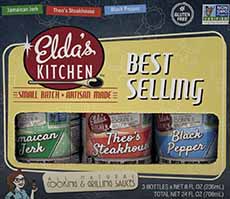Cooking & Grilling Sauces From Elda’s Kitchen For Home Or Gift
|
|
Elda’s Kitchen produces sauces that are very gift-worthy, as well as a treat at your own table. The line of cooking and grilling sauces hits the categories of vegan-friendly, verified Non-GMO, gluten-free, no MSG or preservatives, and no high fructose corn syrup. And they are delicious and worth your attention. We even mixed it into plain yogurt: yum! Essentially, whatever savory food you make, there’s an Elda’s sauce to mix into it, top it, or mix it into. People who love condiments should definitely sample the line. People who need food gifts have six boxed set options (below)that are sure to please. For stocking stuffers and party favors, individual bottles are sold in three-packs. Mankind doubtlessly taught themselves to mix up sauces before our first recorded evidence. The oldest recorded sauce in European cuisine is garum, the fish sauce used by the Ancient Romans. It was ubiquitous, used, as some have described, like modern Americans use ketchup. |
|
|
Doubanjiang, the Chinese fermented soybean sauce, is mentioned in Rites of Zhou in the 3rd century B.C.E. [source]. We know that by 200 C.E., Romans were using a variety of sauces beyond garum. Sauces not only added flavor; they covered up the flavor of less-fresh foods. Apicius, author of the first-known cookbook in the first century B.C.E., wrote at the end of one of his recipes for a particularly flavorsome sauce: “No one at table will know what he is eating” [source]. Roman sauces were usually thickened with wheat flour or crumbled pastry. Honey was used to make a sweet-sour sauce. Each world cuisine evolved to make sauces to complement their foods. They added flavor, moisture, and visual appeal to dishes both savory and sweet. The classic French mother sauces* were created in the 17th century by La Varenne, and codified in the 18th and 19th centuries by Carême and Escoffier. Sauce is a French word, taken from the Latin salsa, meaning salted. Seek them out, and enjoy them. *The mother sauces are tomato, hollandaise, béchamel, velouté, and espagnole. They are further used as a base to create the secondary sauces: mornay, sauce suprême, creole, béarnaise and demi-glace. Here’s more about them here, here and here. †The cookbook, De Re Coquinaria, authored by “Apicius,” is thought to have been compiled in the late 4th or early 5th century C.E. and given that title (“On the Subject of Cooking”). The name Apicius had long been associated with an excessively refined love of food, exemplified by Marcus Gavius Apicius, a Roman gourmet who lived sometime in the 1st century C.E. The author of the book is one Caelius Apicius; however, no person by this name otherwise exists in the historical record. The book was no doubt compiled by a person or persons who wished to remain anonymous [source]. |
||



